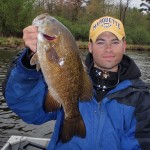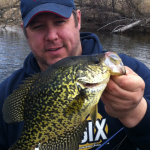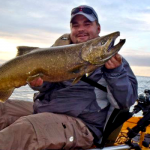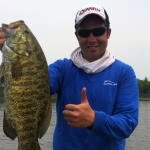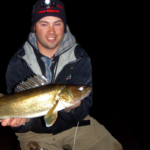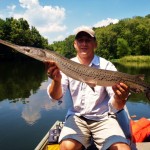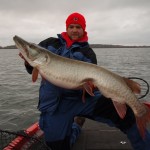By Drew Price – Date Posted: September 15, 2011
For most anglers the word musky (or muskie) conjures up images. Huge aquatic assassins that can eat almost anything but can be very difficult to catch. The fish of 10,000 casts is often said. What if there were a means of angling that helped cut that number down considerably? I have found that a fly rod can be a very effective tool to catch these water wolves. One of my best friends used hardware for muskies until a few years ago. Now he strictly fly fishes for them. Perhaps the best endorsement for the use of the long rod on ‘lunge comes from Brad Bohen, owner and head guide of Musky Country Outfitters who says “Fly rods are flat out deadly in the right hands.” He should know- his guide service landed 161 muskies on the fly last year and he estimates that there will be over 300 boated this year (they are close to half-way at this point in 2011
The most important starting place is basic equipment. What you will want to look into is a good balanced 10 weight outfit. There are plenty of excellent rods on the market and there are now a few pike and musky specific sticks on the market such as the Pike Saber. One of the key elements is to get a fairly lightweight rod that isn’t going to tire you out casting all day, because you will be casting all day. Fast action is probably the best action to choose. Flies will be large and often need to be cast good distances. And the rod also needs to be able to throw multiple lines with ease.
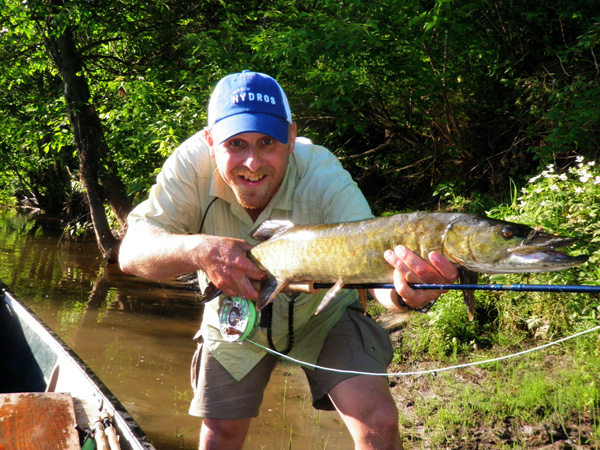
Muskie Reels:
Combine your rod with a decent reel that balances well with the rod you are using. This will help keep the outfit from tiring you out. A good reel doesn’t have to be anything overly fancy, but a good drag is a very nice feature to have. Large and medium arbor reels are excellent choices to help pick up line faster too. One helpful suggestion with reels is to not load them to the max with backing. Muskies don’t tend to run too far or too fast so you can get away with using 200 yards of backing instead of 300, especially with the new gel spun backing. You will find that having that extra space in the spool will make it much easier to put line on your reel during a fight.
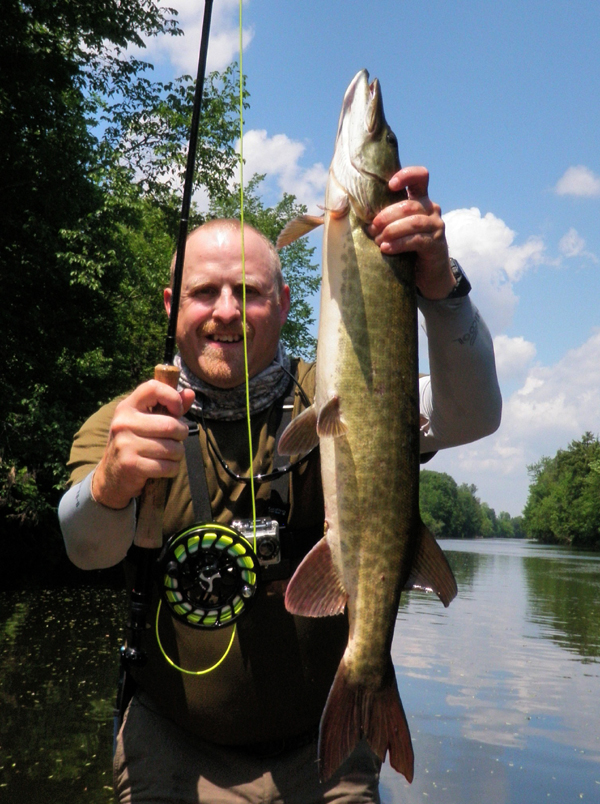
Fly Lines:
There are a wide variety of fly lines on the market right now and many will serve the musky bug chucker well. Fly line choice is heavily dependent upon the time of year and type of fly you will be using. Floating lines are excellent choices for topwater flies and are also great for some streamer applications as well. I highly recommend overlining a rod with a line weight one heavier than the rod or using one of the new specialty lines that are intentionally over the line weight grain size. One example of this is Rio’s Outbound and Outbound short lines. These lines make throwing a larger and or heavier fly much more pleasant. They also help to get the distance you need.
Intermediate, sink tip and sinking lines are really the best bet when fishing streamers. Getting the fly down to the fish and keeping it there makes a huge difference when you are chasing muskies. A variety of these lines will serve the purpose well. It can also require tweaking to suit your needs. Bohen points out “I cut every tip I get down to suit my needs…to match the rod and the fly and the water I intend to fish. Generally I take about 5′-6′ off most standard tips…in the range of 18′-24′ being left and what I work with using my standard 9′ 10wt rod.” For most situations his recommendation is the use of an intermediate line. I would agree that if you have to have one line an intermediate would be the first choice, but to be a versatile angler multiple lines will make a huge difference. The perfect musky line has yet to be designed however. Brad Bohen claims “I’ll say that I think most fly line manufactures have a ways to go in making a good musky fly line…the durability needs to improve as does the manageability of the running lines.”
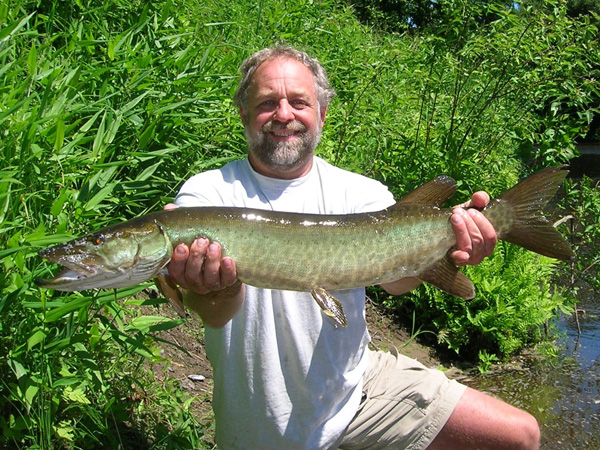
Casting Methods:
No matter what rod/reel/line combination you have and use, be sure you know how to use it properly! Practice casting both distance and accuracy to have your best days on the water. If you want to play the game well you had best put in time using your equipment. If you are a novice fly caster time with a casting instructor that knows big flies and heavy gear is worth its weight in gold. Learn to double haul if you can’t already or get help to improve your current double haul. I promise you that if you do not put any time into casting you will not be as successful as you would like to be and your muscles will hurt you far more at the end of the day (they will hurt if you are casting well too). Remember to practice in all conditions- be ready for anything. If you only practice on sunny, windless days and you get on the water in wind and rain you won’t be ready for it. Once again, Brad puts it best “Time on the water with a 10 weight will bring out the best caster in you.”
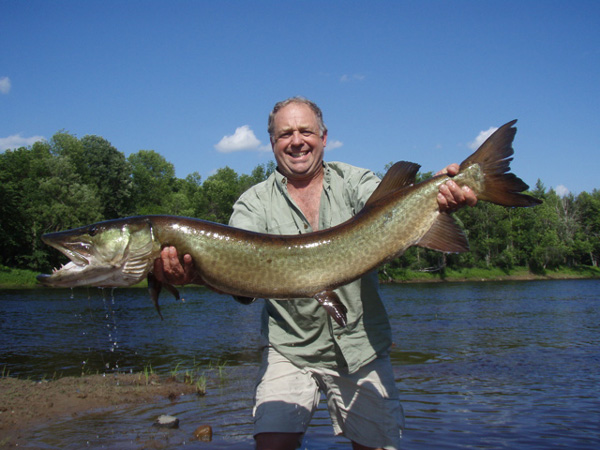
Line Management:
Since you will be making long casts, line management becomes an issue. There may be times you can get out and wade which will make this simpler, but much of the time you will be in a boat. In Bohen’s words “In the musky on the fly game you strip back to the boat and actually bring the fly line to leader butt connection into the tip top guide on nearly every cast.” That leaves a bunch of line on the deck to shoot out each and every cast. A key element to line management is to make sure that your casing area is free of anything that can catch a fly line. When I am out I insist that anglers keep the area around their feet clear of everything- including water bottles, flies, fly boxes, tools, etc. Not only will this help ensure good casting potential but it will also prevent some of these objects from being sent into the drink. Even with your best efforts you will end up with tangles in your running lines. Welcome to the musky on the fly game.
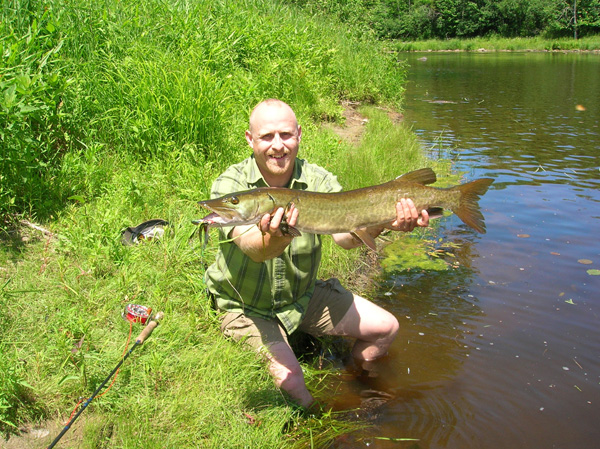
Leaders:
Leaders tend to be pretty subjective to angler preference. When I am fishing with a floating line using topwater flies I use tapered leaders in the 12 to 20lb class. Often I put on a sinking leader to fish streamers with a floating line. A few sinking leaders are worth having in your bag of tricks. They are great for streamers and also for Dahlberg Divers and poppers. They give a bigger pop or deeper diver to a topwater fly. A short leader of less than 4 feet is your best bet on the end of an intermediate or sinking line. Longer leaders have a tendency to cause the fly to float from the end of a sinking line, especially if you use nylon tippet. I am partial to using fluorocarbon tippet most of the time. Fluoro sinks, is less visible, and most importantly, is very abrasion resistant. Depending on what size muskies I expect to encounter I will use anywhere from 15 to 30 lb tippet. Other folks like heavier tippet in the 40 or 50 lb range.
One of the most critical components in the terminal tackle of a musky set up is the bite guard. It seems that every musky angler has his or her own personal preference for this. Brad Bohen and his guides use 18” 60 or 80 lb fluorocarbon bites pre-tied to flies that have a perfection loop on the end. He uses this to form a loop to loop connection with his leader. He can quickly change flies with this set up but he does admit that they will get the occasional bite off with this set up. I am a wire man myself. I use 40 or 60lb tie-able wire most of the time, although I will use lighter for floating flies. I have not had any bite offs with the wire but I will say that I do have to change the wire multiple times in a day of hard fishing. Wire does have a tendency to pig- tail, most notably when tugged hard on a snag. No matter what material you make your wire bite out of, check it often and if it seems like it could be compromised in any manner, change it. Big muskies don’t come to your fly every day and make sure your equipment is up to the task.
Some fly anglers will debate other terminal tackle and whether it should be used for fly fishing. I often use a good swivel of 50 or 80lb between my tippet and bite guard. I do this for two reasons: it makes tying knots simpler and faster and it helps prevent line twist in the fly line. There are anglers that will argue that it adds weight or causes hinging in the leader. Personally neither of these situations has been an issue for me. If you feel that they are, don’t use a swivel. Another piece of terminal tackle that some folks like, my buddy Marty Sienkiewycz included, is a snap or other device to make fly changes easier. He recently started using a clip called a Stringease “Fastach multi-use clip” with great success. I haven’t tried it yet personally, but a day of watching him fish one this summer has me curious enough to try it. No matter what other terminal tackle you use be sure to get good quality components. There is nothing worse than getting into a big fish and loosing it because of a 5 cent swivel.
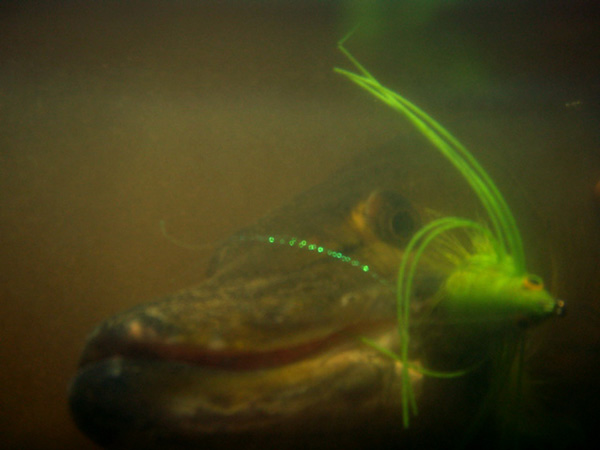
Proper Knot Tying:
There are a number of knots that are very useful to learn for fly fishing for muskies. The Perfection Loop is what you want for loop-to-loop systems. An Albright Knot is one of the best ways to tie tippet directly to either wire or fluorocarbon bite tippet. I use a Trilene Knot to tie tippet to swivels but with heavy tie-able wire or fluorocarbon I will use a Clinch Knot. Perhaps one of the most important knots to know to tie on a fly in wire or fluoro is the Non-Slip Mono Loop Knot. When tied properly this knot gives excellent strength and supplies a loop that imparts action to the fly.
A critical element to any of these knots is to know how to tie them well. Don’t head out on your first musky trip with a knot book, new leader material and hope for the best. It won’t end well. Spend the time that it takes to learn how to tie these knots correctly so they seat well and hold up to abuse. When you are on the water, don’t be afraid to really reef on them to make sure they hold up to the abuse you can give them. I guarantee what you do does not compare to the hurt that a big ‘skie will put on it. Once again, if it doesn’t seem right to you then replace the knot. It is not worth losing a fish over.
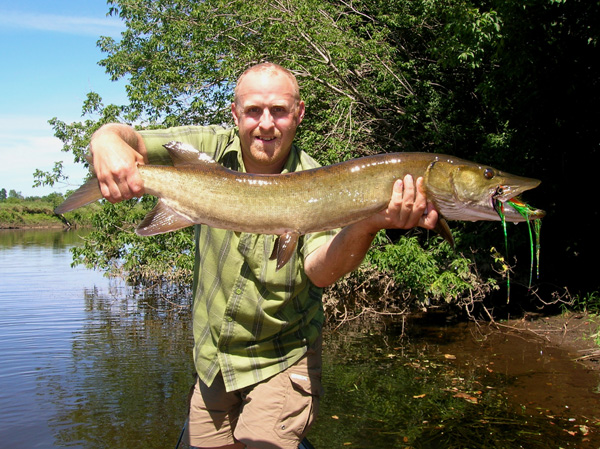
Tools & Accessories:
There are other items that can make your life much nicer on the water. I never leave on any kind of fishing trip without a good pair of pliers that have blades that can cut both tippet and wire. They might be expensive, but they are worth their weight in gold. I carry two sets of jaw spreaders in my bag to make it safer to get flies back. Classic jaw spreaders work well, but round the edges of the jaws with a file to lessen any potential damage to the fish. This year I found Tyrant Tackle’s jaw spreaders which are a lot safer for the fish and I really prefer them. No matter what kind you carry, bring a spare. Once a fish starts going bonkers they are likely to end up on the bottom of the lake or river you are fishing. Another tool I have found useful for both retrieving flies and handling fish is a Boga-Grip. Definitely a safe way to maintain control of a bigger fish but be sure not to lift a musky or pike out of the water vertically with one. Muskies are long fish and lifting them vertically can cause damage to their internal organs.
I always make sure I have a couple of hook hone devices with me: a diamond file and a standard file. Standard files are great to really give a quick sharpen and a diamond file will give you that fine edge that can really get into a muskies mouth quick. I use the thumbnail rule with my flies- if it can stick into my thumbnail with ease then it can stick a musky! The final piece of equipment that I consider critical is a camera. You are going to work hard for a trophy musky and you should have the evidence to prove you got one.
You may have noticed that I did not mention using a net. In a word- don’t! Standard nets are no good for fish like pike and muskies. They fold them unnaturally and have a tendency to slough off a lot of their protective slime. That would be fine if you were to keep one, but if you are like me you will want to release your fish unharmed to get bigger and make more muskies. Remember that a musky over 36” is most likely a female and the larger females produce the most viable eggs. These larger fish are vital to the long term health of musky populations. If you need a landing device use a cradle. Cradles are made specifically for longer fish and are much safer for the fish.
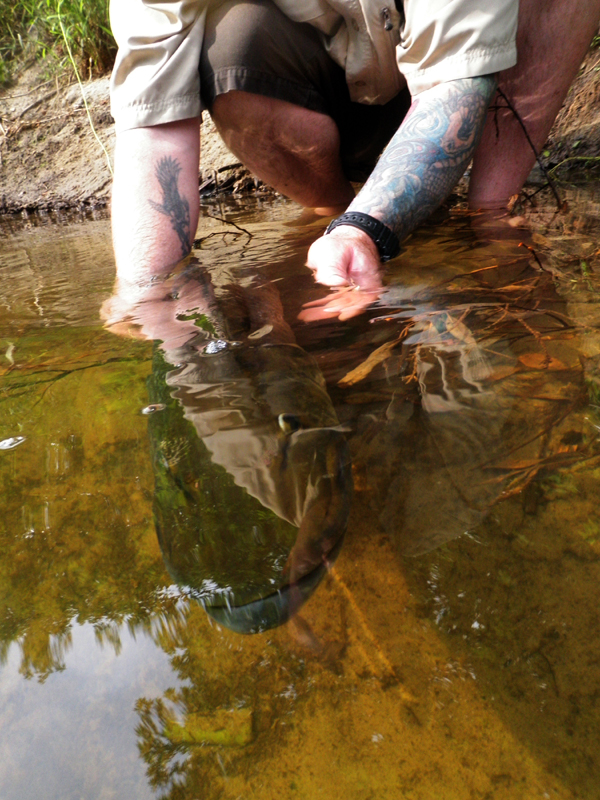
The Pursuit with Fly is Special:
Why go through all of this trouble using a fly rod for muskies when you can chuck big lures instead? Well, I can think of several reasons. First, it is the challenge of fooling an apex predator on a fly. Secondly, it is absolutely deadly if you know what you are doing. Twice I have boated 7 muskies in a day of fishing and Brad Bohen put had a 10 fish day this year. Not too shabby huh? Lastly, it is just a different experience. I have caught some muskies on casting and spinning gear and I had fun with it, but a fly rod is a more sensitive tool. You really feel that connection to the fish much more intimately. Any musky brought to hand gives a real sense of satisfaction, but one caught on a fly seems even more special.
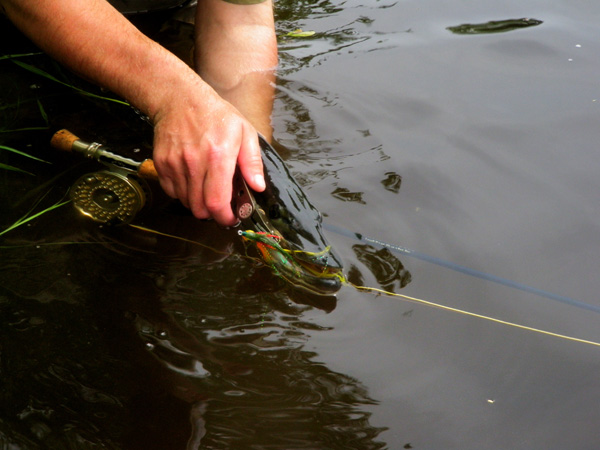
Drew grew up in Northern New York where he received his first fly rod as a college graduation present. He cut his teeth on trout, salmon and bass out of Lake Champlain tributaries but soon realized that there was a lot more to catch with flies. A true fish geek, Drew has worked at a public aquarium and routinely spews fish Latin names despite being deathly allergic to eating his finny friends. He is a science teacher for the school year and spends his summers guiding for warm water fish in the Green Mountain State. Visit Drew’s website at www.drewpriceonthefly.com/



